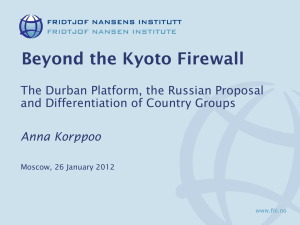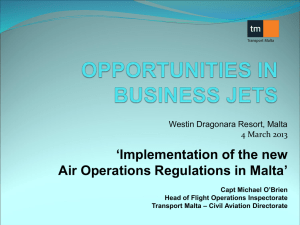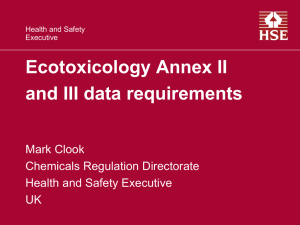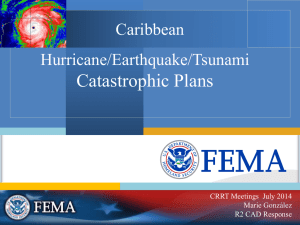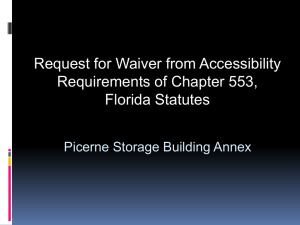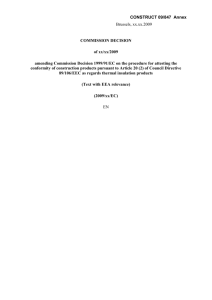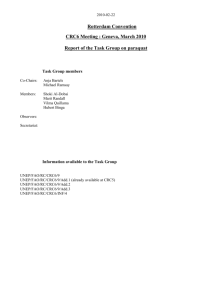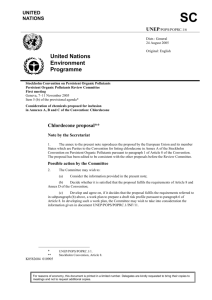Risk management evaluation outline
advertisement
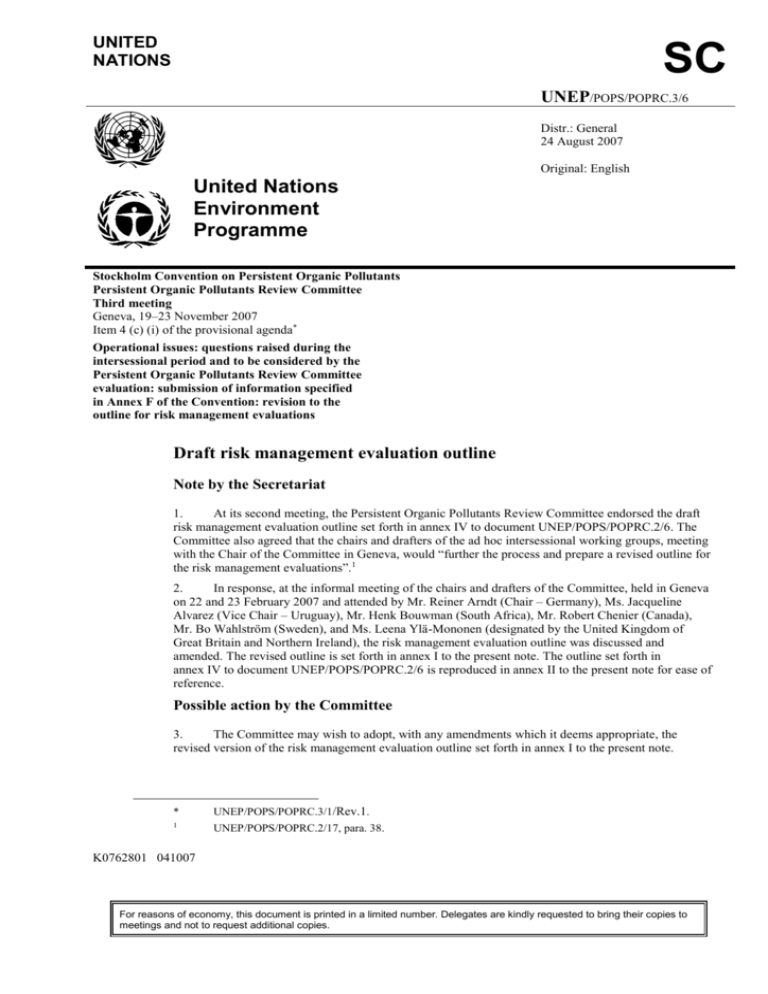
UNITED NATIONS SC UNEP/POPS/POPRC.3/6 Distr.: General 24 August 2007 Original: English United Nations Environment Programme Stockholm Convention on Persistent Organic Pollutants Persistent Organic Pollutants Review Committee Third meeting Geneva, 19–23 November 2007 Item 4 (c) (i) of the provisional agenda* Operational issues: questions raised during the intersessional period and to be considered by the Persistent Organic Pollutants Review Committee evaluation: submission of information specified in Annex F of the Convention: revision to the outline for risk management evaluations Draft risk management evaluation outline Note by the Secretariat 1. At its second meeting, the Persistent Organic Pollutants Review Committee endorsed the draft risk management evaluation outline set forth in annex IV to document UNEP/POPS/POPRC.2/6. The Committee also agreed that the chairs and drafters of the ad hoc intersessional working groups, meeting with the Chair of the Committee in Geneva, would “further the process and prepare a revised outline for the risk management evaluations”.1 2. In response, at the informal meeting of the chairs and drafters of the Committee, held in Geneva on 22 and 23 February 2007 and attended by Mr. Reiner Arndt (Chair – Germany), Ms. Jacqueline Alvarez (Vice Chair – Uruguay), Mr. Henk Bouwman (South Africa), Mr. Robert Chenier (Canada), Mr. Bo Wahlström (Sweden), and Ms. Leena Ylä-Mononen (designated by the United Kingdom of Great Britain and Northern Ireland), the risk management evaluation outline was discussed and amended. The revised outline is set forth in annex I to the present note. The outline set forth in annex IV to document UNEP/POPS/POPRC.2/6 is reproduced in annex II to the present note for ease of reference. Possible action by the Committee 3. The Committee may wish to adopt, with any amendments which it deems appropriate, the revised version of the risk management evaluation outline set forth in annex I to the present note. * UNEP/POPS/POPRC.3/1/Rev.1. 1 UNEP/POPS/POPRC.2/17, para. 38. K0762801 041007 For reasons of economy, this document is printed in a limited number. Delegates are kindly requested to bring their copies to meetings and not to request additional copies. UNEP/POPS/POPRC.3/6 Annex I Risk management evaluation outline Executive summary 1. Introduction 1.1 1.2 Chemical identity of the proposed substance Mention which Party made the proposal and when it was made Spell out the specific chemical identity and particular considerations related to that identity Conclusions of the Review Committee, Annex E information 1.3 2. Data sources Short overview of data submitted by Parties and observers regarding the information specified in Annex F of the Stockholm Convention (N.B. a more elaborated summary of the submissions may be provided as a separate POPRC/INF document) Information on availability of national and international management reports 1.4 Status of the chemical under international conventions 1.5 Any national or regional control actions taken Summary information relevant to the risk management evaluation 2.1 Identification of possible control measures 2.2 2.3 2 2 “the Committee has conducted and evaluated a risk profile in accordance with Annex E (add reference to the meeting and the decision) and has concluded that […]” Short list of possible control measures (such as production prohibition, production restrictions, all use prohibition, restriction of a specific use, phase-out of stocks and articles in use, release control measures, waste disposal and clean-up of contaminated sites) Efficacy and efficiency of possible control measures in meeting risk reduction goals Technical feasibility Identification of critical uses Costs and benefits of implementing possible control measures, including environmental and health costs and benefits Information on alternatives (products and processes) where relevant 2 Description of alternatives Technical feasibility Costs, including environmental and health costs Efficacy, including benefits and limitations of alternatives versus nominated substance and identification of any critical uses for which there is at present no alternative Risk, including information on whether the proposed alternative has been tested/evaluated and any information on potential risks associated with untested alternatives over the life cycle of the alternative Availability Not relevant for unintentionally produced POP candidates. UNEP/POPS/POPRC.3/6 2.4 2.5 3. 4. Accessibility Summary of information on impacts on society of implementing possible control measures Health, including public, environmental and occupational health Agriculture, including aquaculture and forestry Biota (biodiversity) Economic aspects, including costs and benefits for producers and consumers and the distribution of costs and benefits Social costs (employment, etc.) Other impacts Other considerations Access to information and public education Status of control and monitoring capacity Synthesis of information Synthesis of information relevant to the risk management evaluation, in the form of a risk management strategy,3 with emphasis on an analysis of possible control measures for the chemical that leads to the concluding statement The analysis of possible control measures should evaluate the full range of potential control measures and conclude, where possible, whether the recommended strategy/strategies are cost-effective, market-neutral and provide benefits to human health and the environment Concluding statement “Having evaluated the risk profile corresponding to […], and having prepared its risk management evaluation, the Committee concludes that this chemical [is / is not] likely, as a result of long-range environmental transport, to lead to significant adverse effects on human health and/or the environment, such that global action [is / is not] warranted” Therefore, in accordance with paragraph 9 of Article 8 of the Convention, the Committee recommends the Conference of the Parties to the Stockholm Convention [to / not to] consider listing and specifying the related control measures of […] in Annex(es) […] or […]” Inclusion of a statement linking the objective of sustainable development as set forth in the plan of implementation of the World Summit for Sustainable Development4 to the process and work of Persistent Organic Pollutants Review Committee. References to be provided […] 3 This synthesis will include the integration of information on hazard identification, risk assessment, risk control measures evaluation, including a decision-making proposal on control measures, and recommendations for strategy implementation, supervision and review. 4 Report of the World Summit on Sustainable Development, Johannesburg, South Africa, 26 August4 September 2002 (A/CONF.199/20* and corrigendum), chap. I, resolution 2, annex, subparagraph 139 (b): “Integration of the economic, social and environmental dimensions of sustainable development in a balanced manner”. 3 UNEP/POPS/POPRC.3/6 Annex II Draft risk management evaluation outline (reproducing the outline set forth in document UNEP/POPS/POPRC.2/6, annex IV) Executive summary 1. Introduction 1.1 1.2 Chemical identity of the proposed substance Mention which Party has made the proposal and when it was made Spell out the specific chemical identity and particular considerations related to that identity Conclusions of the Review Committee Annex E information 1.3 2. Data sources Short overview of data submitted by Parties and observers, regarding the information specified in Annex F of the Stockholm Convention (NB: a more elaborated summary of the submissions may be provided as a separate POPRC/INF document) Information on availability of national and international management reports 1.4 Status of the chemical under international conventions 1.5 Any national or regional control actions taken Summary information relevant to the risk management evaluation 2.1 Identification of possible control measures 2.2 2.3 5 4 “the Committee has conducted and evaluated a risk profile in accordance with Annex E (add reference to the meeting and the decision) and has concluded that […]” Short list of possible control measures (such as production prohibition, production restrictions, all use prohibition, restriction of a specific use, phase-out of stocks and articles in use, release control measures, waste disposal and clean-up of contaminated sites). Efficacy and efficiency of possible control measures in meeting risk reduction goals Technical feasibility Identification of critical uses Costs and benefits of implementing possible control measures, including environmental and health costs and benefits. Information on alternatives (products and processes), where relevant 5 Description of alternatives Technical feasibility Costs, including environmental and health costs Efficacy, including benefits and limitations of alternatives versus nominated substance and identification of any critical uses for which there is at present no alternative Risk, including information on whether the proposed alternative has been tested/evaluated and any information on potential risks associated with untested alternatives over the life-cycle of the alternative Not relevant for unintentionally produced POP candidates. UNEP/POPS/POPRC.3/6 2.4 2.5 3. 4. Availability Accessibility Summary of information on impacts on society of implementing possible control measures Health, including public, environmental and occupational health Agriculture, including aquaculture and forestry Biota (biodiversity) Economic aspects, including costs and benefits for producers and consumers and the distribution of costs and benefits Movement towards sustainable development Social costs (employment, etc.) Other impacts Other considerations Access to information and public education Status of control and monitoring capacity Synthesis of information Synthesis of information relevant to the risk management evaluation, in the form of a risk management strategy6, with emphasis on an analysis of possible control measures for the chemical that leads to the concluding statement The analysis of possible control measures should evaluate the full range of potential control measures and conclude, where possible, whether the recommended strategy/strategies are cost-effective, market neutral, and provide benefits to human health and the environment. Concluding statement “Having evaluated the risk profile corresponding to […], and having prepared its risk management evaluation, the Committee concludes that this chemical [is / is not] likely, as a result of long-range environmental transport, to lead to significant adverse effects on human health and/or the environment, such that global action [is / is not] warranted. Therefore, in accordance with paragraph 9 of Article 8 of the Convention, the Committee recommends the Conference of the Parties to the Stockholm Convention [to / not to] consider listing and specifying the related control measures of […] in Annex (es) […] or […]” References to be provided _______________ 6 This synthesis will include the integration of information on hazard identification, risk assessment, risk control measures evaluation, including a decision-making proposal on control measures, and recommendations for strategy implementation, supervision and review. 5
